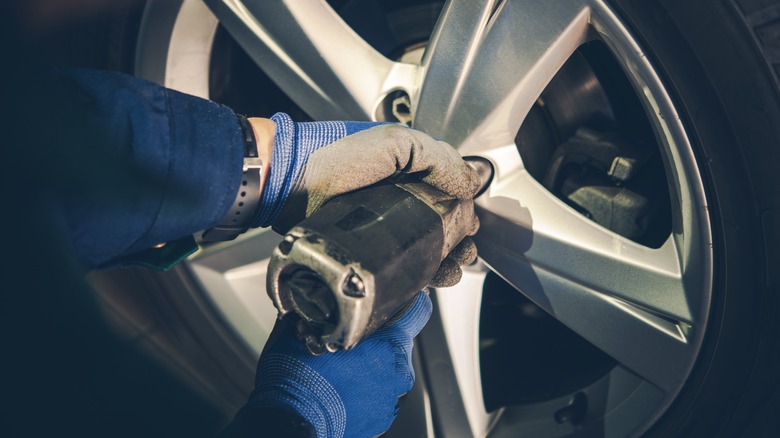Are You Rotating The Tires On Your Car Often Enough? Here's The General Guide
Washing, cleaning the interior, changing the oil, refilling fluids, changing a headlight — vehicle ownership can be a long string of small maintenance tasks like this, and it's important to stay on top of them. Not changing oil regularly, for instance, can impair the engine's performance. Rotating tires is another job that drivers must undertake.
The tricky thing with some of these vital tasks is determining how often to do them. Our vehicles, of course, waste no time telling us when they need charging or fuel, but when it comes to tire rotation, things can be far less clear-cut.
The advice can be somewhat contradictory, and different vehicle models and tire brands may require a different approach. However, there's no "correct" answer to how often you should rotate your tires. Still, there are some general guidelines to follow and reasons why rotating tires should be a driver's priority, regardless of how many miles they accumulate.
How often should you rotate your car tires?
Of course, the type of vehicle you drive and your driving habits will be a factor in how often you should rotate your tires. In terms of basic configuration, Goodyear recommends that owners of larger four-wheel drive vehicles should do so after around every 4,000 miles. Car owners, meanwhile, should rotate their tires every 6,000 miles driven. The complicating factor with this method is that some will take longer to hit these milestones than others, so it can be difficult to gauge. If six months pass before you reach the suggested number of miles, that can be another great interval to choose from.
The Michelin Owner's Manual suggests leaving it no longer than 8,000 miles between rotations, but notes that "tires should be rotated at the first sign of irregular wear," regardless of how recent the previous rotation was. As such, taking time every month to examine each tire and the condition of its tread may be the best way to ensure that no potentially dangerous wear escapes your notice.
In a wider sense, an owner's handbook (a vital tool for drivers of vehicles of all sorts) can provide more specific guidance for particular models and manufacturers. Sam Leeman Ford suggests that all-wheel drive models, the tires of which are potentially more susceptible to wear, should be rotated no less than every 7,500 miles.
Why is it so important to rotate your tires?
Vehicle tires can be very expensive. As a result, just as with any other significant purchase, it's important to try and get the very most (and longest) out of them as possible. Rotation is a crucial aspect of this. Tires naturally accumulate wear and tear as they cover distance, and changing their positions regularly allows a driver to ensure that this wear impacts each of them as evenly as possible.
Consulting your particular vehicle's manual is the best way to determine whether there's a specific approach to doing so. After all, some vehicles have unevenly sized tires between axles, or there may be a set pattern to rotate to and from.
Regardless of the vehicle you drive, rotating tires can be a bit of a pain. It's crucial not to neglect it, though: Not only can you make yourself more vulnerable to the likes of blown tires (the bane of any driver) by not doing so, but you risk even potentially greater weather-related dangers by compromising your tires' ability to grasp tightly to the road. You must always keep yourself and other drivers safe as you travel, and regular tire rotation is an important way of doing just that.


